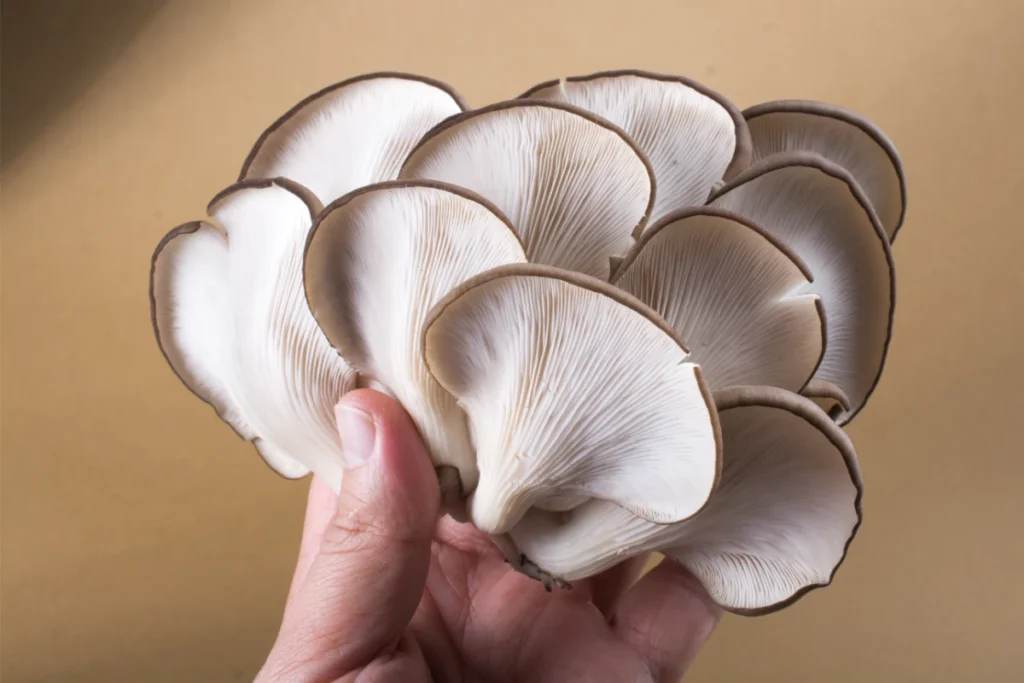Are you tired of the same old button mushrooms on your plate? If so, you’re not alone. A growing number of people are discovering the joys of oyster mushrooms – but how is an oyster mushroom different from a regular mushroom, you might ask? These flavorful, versatile fungi offer a world of culinary possibilities and nutritional benefits that go beyond the ordinary.
In this article, we’ll dive deep into the fascinating differences between oyster mushrooms and the more familiar button mushrooms. We’ll explore their unique tastes, textures, and nutritional profiles, and even touch upon the exciting world of growing your mushrooms at home. Whether you’re a seasoned chef or a curious beginner, get ready to expand your mushroom horizons!
A World Beyond Button Mushrooms: Exploring the Delights of Oyster Mushrooms
The Rise of Interest in Oyster Mushrooms
You might have noticed oyster mushrooms popping up more and more in grocery stores and restaurants lately. That’s because they’re becoming increasingly popular. People are tired of the same old boring button mushrooms and are eager to explore the unique flavors and textures of other varieties. Oyster mushrooms are becoming a culinary darling, thanks to their versatility in cooking, their delicate flavor, and their impressive nutritional content.
What is a “Regular” Mushroom?
When we talk about “regular” mushrooms, we’re usually referring to the ubiquitous button mushroom (Agaricus bisporus). These are the ones you’ll find in most supermarkets, typically sold in white or brown varieties. They’re known for their mild taste and relatively firm texture, making them a staple in many cuisines.
A Sneak Peek into Oyster Mushroom Distinctiveness
Oyster mushrooms, on the other hand, are a different breed altogether. They have a distinctive, slightly sweet flavor and a delicate, almost silky texture. They come in a range of colors, from creamy white to deep gray, and their unique shape resembles an oyster shell. With their captivating appearance and intriguing flavor profile, oyster mushrooms are a real treat for your taste buds.
Taste and Texture
Beyond the Button: Unveiling the Oyster Mushroom’s Unique Flavor Profile
-
A Taste Comparison: Oyster vs. Button Mushroom
The first thing you’ll notice about oyster mushrooms is their distinctive flavor. Unlike the mild, earthy taste of button mushrooms, oyster mushrooms have a more complex, savory profile. They often have a hint of sweetness, reminiscent of anise or licorice, which adds a delightful depth to their flavor.
Think of button mushrooms as the reliable, classic friend you always turn to, while oyster mushrooms are the adventurous, exciting new acquaintance who brings a whole new flavor dimension to the party.
-
Exploring the Oyster Mushroom’s Flavor Notes
The flavor of oyster mushrooms can vary depending on the variety and growing conditions. Some varieties, like the golden oyster mushroom, have a more pronounced, almost umami-like flavor, while others, like the pink oyster mushroom, have a milder, more delicate taste.
Oyster mushrooms also tend to absorb the flavors they’re cooked with, so they’re perfect for incorporating into stir-fries, soups, or pasta dishes. They can even be used in place of meat in vegetarian dishes, adding a meaty texture and an earthy, savory punch.
-
How Texture Plays a Role: Oyster vs. Button
The texture of oyster mushrooms is another key difference. While button mushrooms have a firm, meaty texture, oyster mushrooms are much more delicate and almost silky. They can be slightly chewy when cooked, but they don’t have the same dense texture as button mushrooms. This makes them a great addition to dishes where you want a more subtle, melt-in-your-mouth texture.
-
Culinary Applications: Versatile and Delicious
Oyster mushrooms are incredibly versatile in the kitchen. They can be sautéed, grilled, roasted, or even eaten raw in salads. They also make an excellent ingredient in stir-fries, soups, stews, and pasta dishes.
And for those who are looking for a meat-free alternative, oyster mushrooms are an excellent choice. Their meaty texture and savory flavor make them a great addition to vegetarian burgers, tacos, and other dishes.
Nutritional Powerhouse: A Detailed Comparison
Nourishing the Body: The Nutritional Advantages of Oyster Mushrooms
-
Vitamins and Minerals: A Comprehensive Breakdown
Both oyster mushrooms and button mushrooms are packed with essential nutrients, but oyster mushrooms take the crown in some categories. Here’s a closer look:
- Oyster mushrooms are a good source of B vitamins, especially riboflavin and niacin. These vitamins are essential for energy production, cell growth, and maintaining healthy skin and hair.
- They’re also a decent source of vitamin D, which is important for bone health and immune function.
- Oyster mushrooms are rich in potassium, a mineral that helps regulate blood pressure and muscle function.
- They contain a significant amount of copper, which is vital for iron absorption and energy production.
- Button mushrooms are a good source of selenium, an antioxidant that plays a role in protecting the body against cell damage.
- They’re also a source of vitamin B12, which is crucial for nerve function and cell growth. Button mushrooms are a good source of fiber and protein, but oyster mushrooms provide even more of both.
-
Antioxidant Power: Oyster Mushroom’s Fighting Strength
Oyster mushrooms are superstars when it comes to antioxidants. They are a rich source of compounds like ergothioneine, which has powerful antioxidant and anti-inflammatory properties.
Antioxidants are crucial for protecting your cells from damage caused by free radicals, which contribute to aging and chronic diseases. Eating oyster mushrooms regularly can help boost your antioxidant intake and contribute to overall health and well-being.
-
Fiber and Protein Content: Oyster vs. Button
Oyster mushrooms are a fantastic source of dietary fiber, which is essential for digestive health, regulating blood sugar levels, and promoting feelings of fullness. A single cup of oyster mushrooms provides about 3 grams of fiber, which is more than a cup of button mushrooms.
When it comes to protein, oyster mushrooms also take the lead. They contain a respectable amount of protein, making them a valuable addition to vegetarian and vegan diets.
-
Low-Calorie Delight: A Healthy Choice for Your Plate
Both oyster mushrooms and button mushrooms are naturally low in calories and fat, making them a healthy addition to any diet. A single cup of oyster mushrooms contains only about 20 calories, while a cup of button mushrooms has around 15 calories.
Adding oyster mushrooms to your meals can help you feel fuller for longer without adding excessive calories, which can contribute to weight management goals.
-
Mushrooms and Cholesterol: A Closer Look
Oyster mushrooms are particularly interesting for their potential cholesterol-lowering effects. Some studies have shown that consuming oyster mushrooms may help reduce cholesterol levels, which can contribute to heart health.
More research is needed, but the preliminary findings are promising. Eating oyster mushrooms as part of a healthy diet can be a positive step towards maintaining heart health.
Growing Your Own: Oyster Mushrooms vs. Button Mushrooms
From Farm to Table: A Guide to Growing Oyster and Button Mushrooms
-
The Basics of Mushroom Cultivation: Shared Principles
Growing your mushrooms can be a rewarding experience. It allows you to enjoy fresh, flavorful mushrooms while learning about the fascinating world of mushroom cultivation.
Both oyster mushrooms and button mushrooms require similar conditions for growth. They thrive in cool, dark, and humid environments. They need a suitable substrate, such as straw or sawdust, to provide them with nutrients and moisture.
-
Growing Oyster Mushrooms: A Step-by-Step Guide
Oyster mushrooms are known for being relatively easy to grow at home. You can purchase oyster mushroom growing kits online or at garden centers. These kits contain everything you need to get started, including a substrate block and a bag to contain the growing environment.
Here are the basic steps involved in growing oyster mushrooms at home:
- Prepare your grow space: Choose a cool, dark, and well-ventilated location, like a basement or a closet.
- Mist the substrate: Mist the substrate block with water daily to maintain moisture.
- Monitor temperature: Keep the temperature between 65-75 degrees Fahrenheit (18-24 degrees Celsius)
- Harvest your mushrooms: Once the mushrooms have reached a good size, gently twist them off at the base.
-
Button Mushroom Cultivation: A Simpler Process
Growing button mushrooms can be a bit more challenging, but it’s still doable for beginners. It’s important to maintain a consistent environment for successful button mushroom cultivation.
You can also purchase button mushroom grow kits, or you can attempt to create your own using a suitable substrate and a controlled environment.
-
Homegrown Goodness: Fresh and Flavorful Mushrooms
The satisfaction of growing your mushrooms is truly rewarding. You’ll have access to fresh, flavorful mushrooms whenever you crave them.
Oyster mushrooms are particularly popular for home cultivation because of their quick growth rate and adaptability. They can be grown in a variety of environments, and you can enjoy a fresh harvest within a few weeks.
Whether you choose to grow oyster mushrooms or button mushrooms, the experience will teach you about the delicate balance of nature and the wonder of food production.
Environmental Impact and Sustainability
Mushroom Farming: A Sustainable and Eco-Friendly Choice
-
Oyster Mushroom’s Environmental Advantages
Oyster mushrooms are often hailed as a sustainable and eco-friendly food source. They can be grown on a variety of waste materials, including agricultural byproducts like straw and coffee grounds. This means that oyster mushroom cultivation can help reduce waste and promote circularity in the food system.
Oyster mushrooms are also known for their ability to break down lignin, a complex organic compound found in wood and other plant materials. This means they can help decompose waste materials more efficiently, contributing to a healthier soil environment.
-
Button Mushroom Cultivation: Environmental Considerations
Button mushrooms are typically grown in large-scale operations, which can have a significant environmental impact. Their cultivation often involves the use of pesticides and fertilizers, which can potentially contaminate water sources and harm biodiversity.
While some button mushroom farmers are adopting more sustainable practices, there is still room for improvement in the industry.
-
The Future of Sustainable Mushroom Farming
The future of mushroom farming is looking bright. As consumers become more aware of the environmental impact of food production, there is a growing demand for sustainable options.
Oyster mushrooms and other varieties of mushrooms are gaining popularity as eco-friendly alternatives to traditional meat and dairy products. With their nutritional benefits and minimal environmental footprint, mushrooms are poised to play an increasingly important role in sustainable food systems.
Choosing the Right Mushroom for You
Navigating the Mushroom Market: Oyster or Button?
-
Taste Preferences: A Deciding Factor
Ultimately, the choice between oyster mushrooms and button mushrooms comes down to your personal preferences. If you prefer a mild, earthy flavor, then button mushrooms might be the way to go.
But if you’re looking for something more adventurous with a hint of sweetness and a delicate texture, oyster mushrooms will satisfy your cravings.
-
Nutritional Goals: Prioritizing Your Needs
If you’re looking for a nutrient-rich food, both oyster mushrooms and button mushrooms are excellent choices. However, oyster mushrooms offer a higher concentration of certain vitamins and minerals, including vitamin D and potassium.
-
Cultivation and Availability: Finding the Right Fit
Oyster mushrooms are becoming increasingly available in grocery stores and farmers’ markets. They are also relatively easy to grow at home, making them a convenient and sustainable option. Button mushrooms, on the other hand, are more widely available, but they might not always be as fresh as oyster mushrooms.
FAQs
Are oyster mushrooms more expensive than button mushrooms?
- Oyster mushrooms can sometimes be slightly more expensive than button mushrooms, but the price difference is often minimal. The cost of mushrooms can vary depending on the season, availability, and the specific variety.
Can I grow oyster mushrooms indoors?
- Yes, absolutely! Oyster mushrooms are known for being easy to grow indoors. You can purchase oyster mushroom grow kits online or at garden centers, which contain everything you need to get started.
Are oyster mushrooms safe to eat raw?
- While oyster mushrooms can be eaten raw, they are generally best cooked. Cooking helps to break down their tough texture and enhance their flavor.
It’s also important to note that mushrooms can sometimes contain trace amounts of pesticides, so cooking them can help reduce the risk of exposure.
Are oyster mushrooms good for weight loss?
- Oyster mushrooms are a low-calorie and nutrient-rich food, which can be beneficial for weight loss. They’re also a good source of fiber, which can help you feel fuller for longer, reducing cravings and overeating.
Conclusion
Embracing the Variety: Oyster and Button Mushrooms in Harmony
-
Exploring New Culinary Horizons
The culinary world is filled with endless possibilities, and mushrooms play a key role in creating delicious and nutritious dishes. Oyster mushrooms offer a unique flavor and texture that can elevate your culinary creations.
While button mushrooms remain a classic choice, oyster mushrooms add a touch of excitement and intrigue to your meals.
-
A World of Mushroom Delights
Don’t be afraid to venture beyond the familiar. The world of mushrooms is full of flavor and variety. From the delicate oyster mushroom to the robust portobello mushroom, there’s a mushroom out there to suit every taste and preference.
So, next time you’re at the grocery store, consider picking up a package of oyster mushrooms and see for yourself what all the fuss is about. You might just discover a new favorite.
More Delicious Recipes:
- Papusas: Discover the delightful taste of pupusas, a traditional Salvadoran dish that will take your taste buds on a journey. These thick, handmade corn tortillas are filled with a variety of savory ingredients like cheese, beans, and meats, offering a perfect blend of flavors and textures.
- Vermicelli: Dive into the world of vermicelli, a versatile ingredient that can transform any meal. Whether it’s in a light, refreshing salad or a warm, comforting stir-fry, vermicelli noodles offer endless culinary possibilities. Packed with flavor and easy to prepare, our vermicelli recipes will inspire you to create delicious and nutritious dishes.
Vermicelli: A Comprehensive Guide to Types, Uses, and Recipes




1 thought on “How is oyster mushroom different from regular mushroom?”